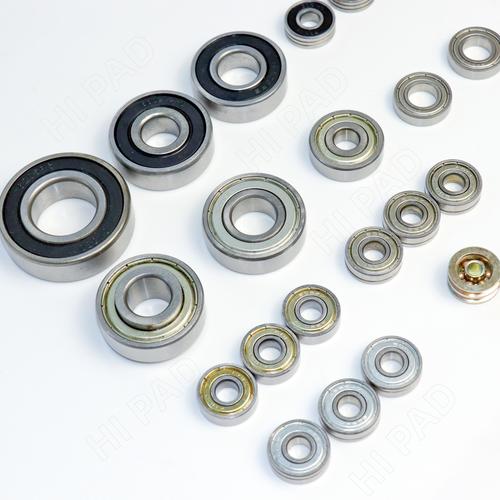Industrial Ball Bearings: Essential Guide for Maintenance, Lubrication, and Performance Optimization
Industrial ball bearings are critical components in machinery, enabling smooth rotation by reducing friction between moving parts. Designed to handle radial and axial loads, they are widely used in manufacturing, automotive, and aerospace industries. This guide explores key aspects of selecting, maintaining, and troubleshooting industrial ball bearings for optimal equipment performance.
Table of Contents
1. Industrial ball bearings maintenance tips2. High temperature industrial ball bearings
3. Industrial ball bearings load capacity
4. Industrial ball bearings lubrication guide
5. Industrial ball bearings failure analysis
1. Industrial Ball Bearings Maintenance Tips
 Proper maintenance extends bearing lifespan significantly. Always clean bearings before inspection using solvent baths or ultrasonic cleaners. Monitor vibration levels monthly with precision instruments—abnormal frequencies often indicate misalignment or wear. Implement condition-based lubrication schedules rather than fixed intervals. For sealed bearings, avoid over-greasing as it increases internal pressure. Store spare bearings in climate-controlled environments to prevent corrosion. Use laser alignment tools during installation to ensure angular accuracy below 0.001 radians. Document maintenance activities systematically to identify recurring issues.
Proper maintenance extends bearing lifespan significantly. Always clean bearings before inspection using solvent baths or ultrasonic cleaners. Monitor vibration levels monthly with precision instruments—abnormal frequencies often indicate misalignment or wear. Implement condition-based lubrication schedules rather than fixed intervals. For sealed bearings, avoid over-greasing as it increases internal pressure. Store spare bearings in climate-controlled environments to prevent corrosion. Use laser alignment tools during installation to ensure angular accuracy below 0.001 radians. Document maintenance activities systematically to identify recurring issues.
2. High Temperature Industrial Ball Bearings
Bearings operating above 120°C require specialized materials like silicon nitride or ceramic hybrids. Standard steel bearings lose hardness at 150°C, leading to premature failure. Always verify the thermal expansion coefficients when pairing bearings with shafts. High-temperature greases with lithium complex or polyurea thickeners maintain viscosity better under heat. Consider oil-air lubrication systems for continuous 200°C environments. Thermal shields or cooling jackets can reduce operational temperatures by 15-20%. Regularly check cage integrity in high-heat applications as plastic retainers may deform.
3. Industrial Ball Bearings Load Capacity
Dynamic load ratings (C) and static load ratings (C0) determine bearing selection. For pulsating loads, apply a safety factor of 1.5-2x the calculated load. Angular contact bearings handle combined loads better than deep groove types. Preloading adjustments can increase axial stiffness by up to 40% in machine tool applications. Use finite element analysis (FEA) to predict stress distribution in heavy-load scenarios. Avoid exceeding the basic static load rating—permanent deformation occurs beyond this threshold. Consult ISO 281:2007 standards for life expectancy calculations under variable loads.
4. Industrial Ball Bearings Lubrication Guide
Select grease NLGI grades based on speed: Grade 2 for <1,500 RPM, Grade 1 for higher speeds. Mineral oils suit most applications, but synthetic lubricants outperform in extreme temperatures. For food-grade environments, use NSF H1-registered greases. Relubrication intervals depend on the formula: polyurea grease lasts 30% longer than lithium-based alternatives. Automate lubrication with progressive pumps to ensure consistent dosing. Conduct oil analysis quarterly to detect contamination from metal particles or moisture.
5. Industrial Ball Bearings Failure Analysis
Common failure modes include spalling (45% of cases), brinelling (20%), and lubrication breakdown (18%). Use scanning electron microscopy to examine fatigue fractures. Electrical arcing damage shows distinctive fluting patterns on raceways. Implement root cause analysis (RCA) for recurring failures—misalignment accounts for 34% of premature bearing deaths. Track failure rates using Weibull analysis to predict MTBF. Replace bearings in matched pairs when used in tandem configurations to prevent uneven load distribution.
Understanding these five critical aspects—maintenance protocols, high-temperature resilience, load management, lubrication techniques, and failure diagnostics—empowers engineers to maximize bearing efficiency. Whether you're combating thermal stress in steel mills or optimizing CNC machine precision, this comprehensive guide provides actionable solutions. Dive deeper into each section to uncover specialized strategies tailored to your industrial needs.
In conclusion, industrial ball bearings are precision components requiring meticulous care and technical expertise. By adhering to maintenance best practices, selecting appropriate materials for operational conditions, and utilizing advanced diagnostic tools, businesses can significantly reduce downtime and operational costs. Implementing these insights ensures reliable machinery performance across diverse industrial applications.




 13869596835
13869596835